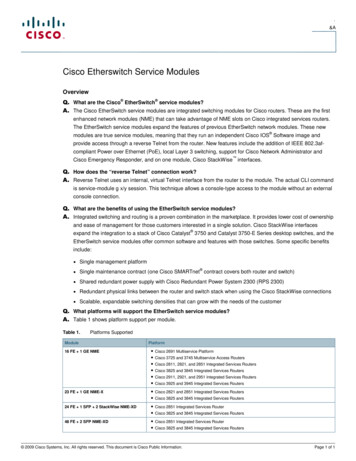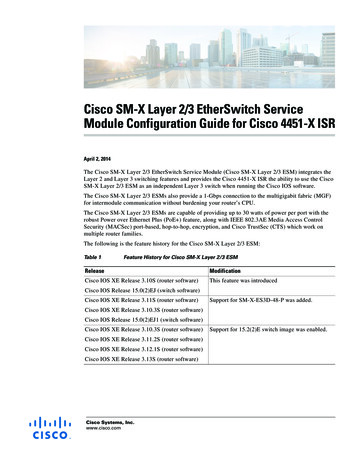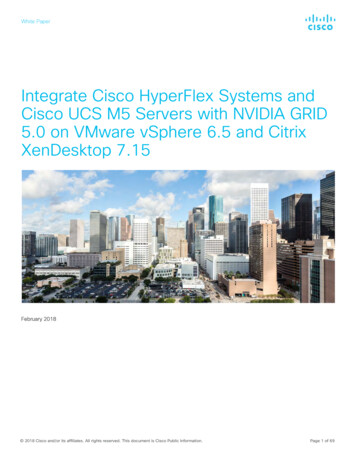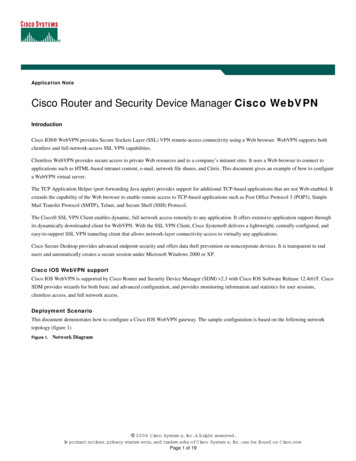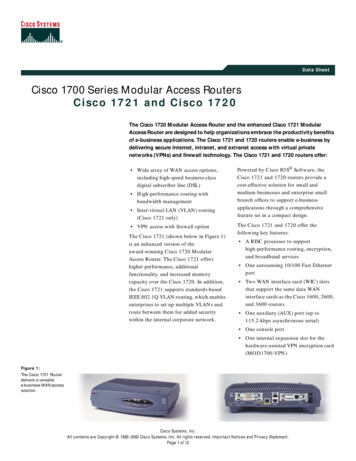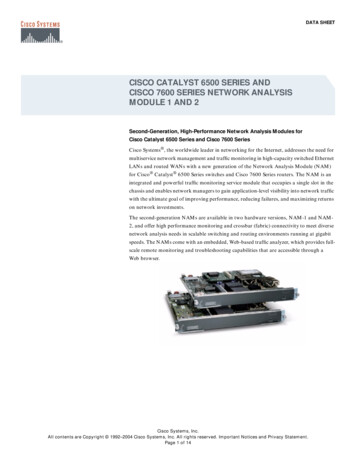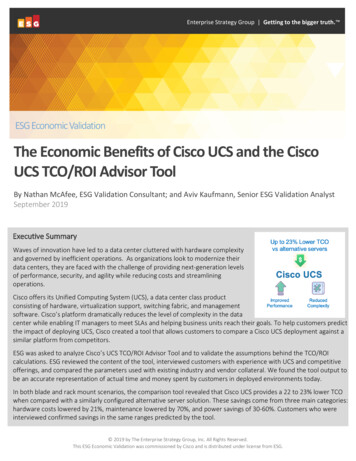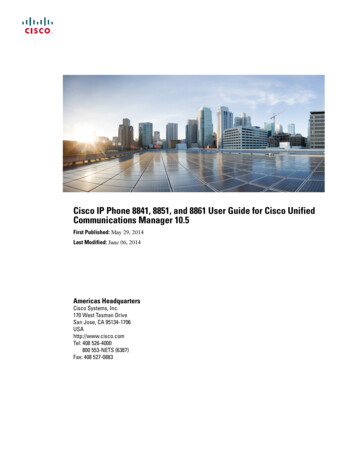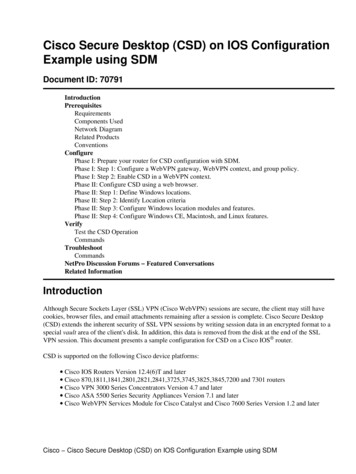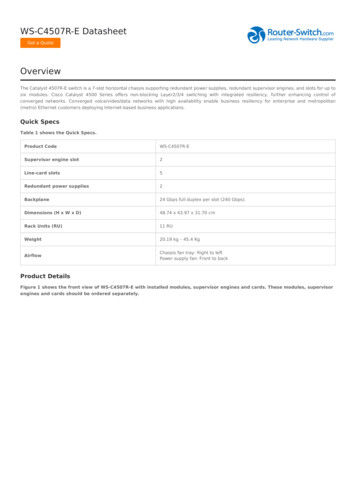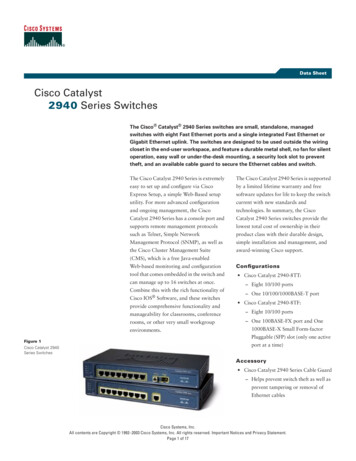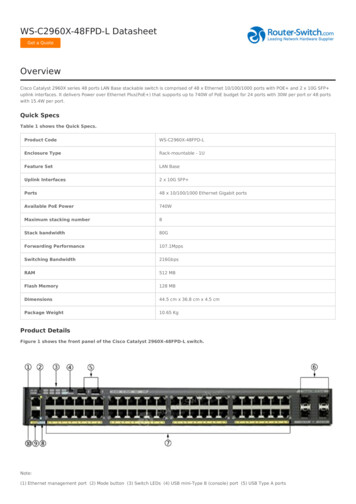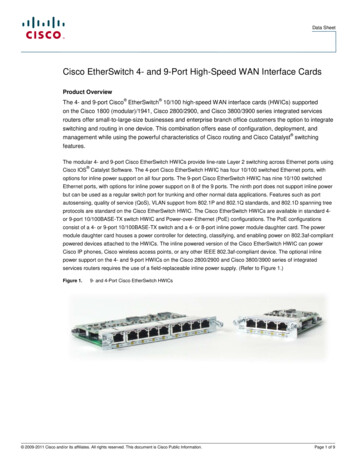
Transcription
Data SheetCisco EtherSwitch 4- and 9-Port High-Speed WAN Interface CardsProduct Overview The 4- and 9-port Cisco EtherSwitch 10/100 high-speed WAN interface cards (HWICs) supportedon the Cisco 1800 (modular)/1941, Cisco 2800/2900, and Cisco 3800/3900 series integrated servicesrouters offer small-to-large-size businesses and enterprise branch office customers the option to integrateswitching and routing in one device. This combination offers ease of configuration, deployment, and management while using the powerful characteristics of Cisco routing and Cisco Catalyst switchingfeatures.The modular 4- and 9-port Cisco EtherSwitch HWICs provide line-rate Layer 2 switching across Ethernet ports using Cisco IOS Catalyst Software. The 4-port Cisco EtherSwitch HWIC has four 10/100 switched Ethernet ports, withoptions for inline power support on all four ports. The 9-port Cisco EtherSwitch HWIC has nine 10/100 switchedEthernet ports, with options for inline power support on 8 of the 9 ports. The ninth port does not support inline powerbut can be used as a regular switch port for trunking and other normal data applications. Features such as portautosensing, quality of service (QoS), VLAN support from 802.1P and 802.1Q standards, and 802.1D spanning treeprotocols are standard on the Cisco EtherSwitch HWIC. The Cisco EtherSwitch HWICs are available in standard 4or 9-port 10/100BASE-TX switch HWIC and Power-over-Ethernet (PoE) configurations. The PoE configurationsconsist of a 4- or 9-port 10/100BASE-TX switch and a 4- or 8-port inline power module daughter card. The powermodule daughter card houses a power controller for detecting, classifying, and enabling power on 802.3af-compliantpowered devices attached to the HWICs. The inline powered version of the Cisco EtherSwitch HWIC can powerCisco IP phones, Cisco wireless access points, or any other IEEE 802.3af-compliant device. The optional inlinepower support on the 4- and 9-port HWICs on the Cisco 2800/2900 and Cisco 3800/3900 series of integratedservices routers requires the use of a field-replaceable inline power supply. (Refer to Figure 1.)Figure 1.9- and 4-Port Cisco EtherSwitch HWICs 2009-2011 Cisco and/or its affiliates. All rights reserved. This document is Cisco Public Information.Page 1 of 9
Data SheetCisco Etherswitch HWIC SummaryTable 1 gives the product numbers for the 4- and 9-port Cisco EtherSwitch HWICs.Table 1.Product Numbers for 4- and 9-Port Cisco EtherSwitch HWICsProduct NumberDescriptionHWIC-4ESW4-port Cisco EtherSwitch 10BASE-T/100BASE-TX autosensing HWICHWIC-4ESW-POE*4-port Cisco EtherSwitch 10BASE-T/100BASE-TX autosensing HWIC with power daughter cardHWIC-D-9ESW9-port Cisco EtherSwitch 10BASE-T/100BASE-TX autosensing HWICHWIC-D-9ESW-POE**9-port Cisco EtherSwitch 10BASE-T/100BASE-TX autosensing HWIC with power daughter cardTable 2 gives the power supply options for the Cisco Integrated Services Routers to support inline power on the4- and 9-port HWICs.Table 2.Power Supply Product NumbersProduct NumberDescriptionPWR-2801-AC-IP Cisco 2801 AC inline power supplyPWR-2811-AC-IP Cisco 2811 AC inline power supplyPWR-2821-51-AC-IP Cisco 2821 and Cisco 2851 AC inline power supplyPWR-3825-AC-IP Cisco 3825 AC-IP power supplyPWR-3845-AC-IP Cisco 3845 AC-IP power supplyPWR-1941-POE Cisco 1941 POE Power SupplyPWR-2901-POE Cisco 2901 POE Power SupplyPWR-2911-POE Cisco 2911 POE Power SupplyPWR-2921-51-POE Cisco 2921 and 2951 POE Power SupplyPWR-3900-POE Cisco 3900 POE Power SupplyPlatform SupportTable 3 lists the supported platforms for the 4- and 9-port Cisco EtherSwitch HWICs.Table 3.Supported Platforms for 4- and 9-Port Cisco EtherSwitch HWICsChassis4-Port Cisco EtherSwitch HWIC9-Port Cisco EtherSwitch HWICInternal Inline Power Supply (optional)Cisco 1841Yes, 2 HWICs per routerNoNoCisco 2801Yes, 2 HWICs per routerYes, 2 HWICs per routerYesCisco 2811Yes, 2 HWICs per routerYes, 2 HWICs per routerYesCisco 2821Yes, 2 HWICs per routerYes, 2 HWICs per routerYesCisco 2851Yes, 2 HWICs per routerYes, 2 HWICs per routerYesCisco 3825Yes, 2 HWICs per routerYes, 2 HWICs per routerYesCisco 3845Yes, 2 HWICs per routerYes, 2 HWICs per routerYesCisco 1941Yes, 2 HWICs per routerYesYesCisco 2901Yes, 2 HWICs per routerYes, 2 HWICs per routerYesCisco 2911Yes, 2 HWICs per routerYes, 2 HWICs per routerYesCisco 2921Yes, 2 HWICs per routerYes, 2 HWICs per routerYesCisco 2951Yes, 2 HWICs per routerYes, 2 HWICs per routerYesCisco 3925Yes, 2 HWICs per routerYes, 2 HWICs per routerYesCisco 3945Yes, 2 HWICs per routerYes, 2 HWICs per routerYes 2009-2011 Cisco and/or its affiliates. All rights reserved. This document is Cisco Public Information.Page 2 of 9
Data SheetApplicationsSmall Branch Data OnlyFigure 2 shows an example of a deployment for a small-to-large enterprise branch office.Figure 2.Typical Data-Only Deployment for a Small-to-Large Enterprise Branch OfficeA Cisco EtherSwitch HWIC in an enterprise branch data deployment scenario provides the flexibility of integratedrouting and switching functions in one unit for low port densities. This deployment provides high-speed connectionsbetween individual desktops, servers, and other network resources in a single unit for Layer 2 and allows WANconnection at Layer 3 through the router.Figure 3 shows an example of a typical converged deployment for a small-to-large enterprise branch office withIP phones.Figure 3.Typical Converged Deployment for a Small-to-Large Enterprise Branch Office with IP Phones 2009-2011 Cisco and/or its affiliates. All rights reserved. This document is Cisco Public Information.Page 3 of 9
Data SheetThe 4- or 9-port Cisco EtherSwitch HWICs when combined with analog or digital voice modules for the CiscoIntegrated Services Routers provide a small-to-large enterprise branch office infrastructure for IP telephonydeployments. This solution can be combined with Cisco CallManager Express IP Telephony or the Cisco IOSSoftware Survivable Remote Site Telephony (SRST) solution. SRST runs on the local branch office router, allowing itto automatically detect a failure in the network, and initiates a process to intelligently autoconfigure the router toprovide call-processing backup redundancy for the IP phones in that office. In the case of a Cisco CallManagerExpress deployment, call-processing features are offered on the branch router without a centralized call manager.The Cisco EtherSwitch HWIC with the optional internal chassis provides IP phone power and phone discovery for IPphones. In addition, the Cisco EtherSwitch HWIC supports separate VLAN configuration for IP phones. The auxiliaryVLAN feature allows network administrators to segment phones into separate logical networks, even though the dataand voice infrastructures are physically the same. The phone discovery feature allows the Cisco 4- and 9-portEtherSwitch HWICs (product numbers HWIC-4ESW-POE or HWIC-D-9ESW-POE) to automatically detect thepresence of an IP phone and supply inline power.Features and BenefitsTable 4 gives the architecture, features, and benefits of the Cisco 4- and 9-port HWICs.Table 4.Architecture, Features, and Benefits of 4- and 9-Port Cisco EtherSwitch HWICsFeatureBenefit4 or 9 10BASE-T/100BASE-TX Ports These ports deliver up to 200 Mbps of aggregate bandwidth (full duplex) for forwarding Layer 2 traffic oneach port.Autosensing, Autonegotiation, andAuto-MDIX (Automatic MediaDependant Interface Crossed Over) The Autosensing feature allows the switch to detect the speed of the attached device and automaticallyconfigure the port for 10- or 100-Mbps operation. The Autonegotiation feature allows the switch to automatically select half- or full-duplex transmissionmode to optimize bandwidth on all the ports of the HWIC The Auto-MDIX feature allows the switch to automatically detect cable type (straight through vs.crossover) between the attached Ethernet device and switch line pairs.Integrated Switching Integrated switching provides fewer points of management for remote and small branch offices.802.1P QoS (Traffic Prioritization) This feature provides support for QoS based on the IEEE class of service (CoS) and port-basedprioritization, allowing the switch to change the CoS settings of tagged packets on a per-port basis.802.1Q Trunking This feature allows the setup of separate VLANs with tagged and untagged framing; trunking is used tosave ports when creating a link between two devices implementing VLANs; VLANs allow segmentation ofthe LAN.802.1D Spanning Tree Protocol This Layer 2 link-management protocol provides path redundancy while preventing undesirable loops inthe network; it simplifies network configuration and improves fault tolerance.Voice VLAN (VVLAN) VVLANs help enable Cisco IP phones to place voice and data in their own separate VLANs. The HWICswitch port is manually configured as a trunk port to support voice and data VLANs on the same port. Theswitch then uses Cisco Discovery to dynamically configure the Cisco IP phones.802.1x Authentication This client-server-based access control and authentication protocol restricts unauthorized devices fromconnecting to a LAN through publicly accessible ports.PoE (Option) Cisco EtherSwitch technology with the appropriate inline power module and internal power supply canpower Cisco IP phones and wireless access points. Support is provided for both IEEE 802.3af PoE andCisco prestandard inline powered devices. The ninth port of the 9-port HWIC (part number HWIC-D9ESW-POE) cannot be used for PoE applications. The PoE option is not available on the Cisco 1841router.Multicast Management Support This feature offers Internet Group Management Protocol (IGMP) snooping in hardware for managementsupport.Simple Network ManagementProtocol (SNMP) Management SNMP allows management of the MIB through a MIB browser.Cisco IOS Software Command-LineInterface (CLI) This feature provides configuration through the Cisco IOS Software CLI and provides a common userinterface for all the router functions.CiscoWorks Support CiscoWorks network management software helps enable manageability on a per-port and per-switchbasis, providing a common management interface for Cisco routers, switches, and hubs. SNMPv1, v2, and v3 (noncryptographic) and Telnet interface support delivers comprehensive in-bandmanagement, and a CLI management console provides detailed out-of-band management. Cisco Discovery Protocol Versions 1 and 2 help enable a CiscoWorks network management station toautomatically discover the switch in a network topology. 2009-2011 Cisco and/or its affiliates. All rights reserved. This document is Cisco Public Information.Page 4 of 9
Data SheetFeatureBenefit Support is provided by the CiscoWorks LAN Management Solution.Cisco Discovery Protocol Versions1 and 2 This protocol enables a CiscoWorks network management station to automatically discover the switch ina network topology.VLAN Trunking Protocols (Client,Server, and Transparent Modes) The Cisco Virtual Lan Trunking Protocol (VTP) supports dynamic VLAN configuration across Ciscoswitches.Cisco Secure Router and DeviceManager (SDM)-BasedConfiguration and DeviceManagement This feature simplifies initial configuration of a switch through a Web browser, eliminating the need formore complex terminal emulation programs and CLI knowledge. Cisco SDM reduces the cost of deployment by helping less-skilled personnel set up switches quickly andsimply.Status LEDs Two LEDs per port provide convenient visual indication of the switch port and inline power status.Summary and ConclusionThe 4- and 9-port Cisco EtherSwitch HWICs (part numbers HWIC-4ESW and HWIC-D-9ESW) are managed10/100BASE-T Layer 2 switches in a HWIC form factor for the Cisco Integrated Services Routers. The 4-port HWICcomes in a single-wide form factor, and the 9-port HWIC in a double-wide form factor. The switch supports the IEEE802.1D Spanning Tree Protocol and can be used to connect up to 4 or 9 LANs with up to 15 IEEE 802.1Q-basedVLANs (802.1Q). Note: Both HWICs-the 4- and 9-port HWICs-support up to 15 VLANs. They also can be optionallyconfigured to provide 4 or 8 ports of inline power for 802.3af- or Cisco PoE-capable devices. The PoE support is notavailable on the Cisco 1841 router.SpecificationsTable 5 gives product specifications of the 4- and 9-port Cisco EtherSwitch HWICs.Table 5.Product Specifications of 4- and 9-Port Cisco EtherSwitch HWICs (HWIC-4ESW, HWIC-4ESW-POE, HWIC-D9ESW,and HWIC-D-9ESW-POE)FeatureBenefitTarget ApplicationsData, voice, and videoSupported Router Platforms Cisco 1800 (modular), Cisco 2800, and Cisco 3800 series integrated services routers: Cisco 1841 (supports HWIC-4ESW only; no PoE support) Cisco 2801 Cisco 2811 Cisco 2821 Cisco 2851 Cisco 3825 Cisco 3845 Cisco 1941 Cisco 2901 Cisco 2911 Cisco 2921 Cisco 2951 Cisco 3925 Cisco 3945Form Factor HWIC-4ESW Single-wide HWIC form factor HWIC-D-9ESW Double-wide HWIC form factorDimensions (W x D x H) HWIC-4ESW 3.08 x 4.74 x 0.76 in. HWIC-D-9ESW 6.20 x 4.74 x 0.76 in.Weight HWIC-4ESW 79 grams (0.17 lb) HWIC-4ESW-POE 108 grams (0.24 lb) HWIC-D-9ESW 149 grams (0.33 lb) HWIC-D-9ESW-POE 196 grams (0.43 lb)StandardsIEEE Protocols Ethernet: IEEE 802.3, 10BASE-T Fast Ethernet: IEEE 802.3u, 100BASE-TX 2009-2011 Cisco and/or its affiliates. All rights reserved. This document is Cisco Public Information.Page 5 of 9
Data SheetFeatureBenefit IEEE 802.1d Spanning Tree Protocol IEEE 802.1p CoS for Traffic Prioritization IEEE 802.1q VLAN IEEE 802.1x Security IEEE 802.3x Full Duplex IEEE 802.3af Power over Ethernet StandardRFCRFC 2284, PPP Extensible Authentication Protocol (EAP)MIBs RFC 1213 IF MIB CISCO-VLAN-MEMBERSHIP-MIB CISCO-VLAN-IFINDEX-RELATIONSHIP-MIB RFC 2037 ENTITY MIB CISCO-CDP-MIB RMON1-MIB PIM-MIB CISCO-IMAGE-MIB CISCO-FLASH-MIB CISCO-STP-EXTENSIONS-MIB OSPF MIB (RFC 1253) OLD-CISCO-CHASSIS-MIB CISCO-VTP-MIB IPMROUTE-MIB CISCO-MEMORY-POOL-MIB CISCO-HSRP-MIB OLD-
PWR-2901-POE Cisco 2901 POE Power Supply PWR-2911-POE Cisco 2911 POE Power Supply PWR-2921-51-POE Cisco 2921 and 2951 POE Power Supply PWR-3900-POE Cisco 3900 POE Power Supply Platform Support Table 3 lists the supported platforms for the 4- and 9-port Cisco EtherSwitch HWICs. Table 3. Supported Platforms for 4- and 9-Port Cisco EtherSwitch HWICs Chassis 4-Port Cisco
